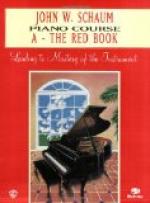“One thing a teacher should insist upon, and that is that the pupil should study harmony. He should have a practical working knowledge of keys, chords, and progressions. There may be no need for him to study orchestration or composition, but he must know the foundation and structure of the material of music. My pupil must be familiar with the various chords of the scale and know how to analyze them, before I can make clear to him the rules of pedaling. Without this knowledge, my words about the use of the pedals are as so much Greek to him. He must go and learn this first, before coming to me.
ACCORDING TO RULE
“Experience counts for much with the teacher, but much, more with the pianist. The beginner must go according to rule, until he has thoroughly mastered the rules. He must not think because he sees a great artist holding his hands a certain way at times—turning under his unemployed fingers for octaves perhaps, or any other seeming eccentricity, that he himself is at liberty to do the same things. No, he must learn to play in a normal, safe way before attempting any tricks. What may seem eccentric to the inexperienced student may be quite a legitimate means of producing certain effects to the mature artist, who through wide experience and study knows just the effect he wants and the way to make it. The artist does many things the pupil should not attempt. The artist knows the capabilities of his own hand; his technic is, in a certain sense, individual; it should not be imitated by the learner of little or no experience. If I play a chord passage with high wrist, that I may bring out a certain effect or quality of tone at that point, the thoughtless student might be under the impression that a high wrist was habitual with me, which is not true. For this reason I do not give single lessons to any one, nor coach on single pieces. In the case of the interpretation of a piece, a student can get the ideas of it from hearing it in recital, if he can grasp and assimilate them.
ON INTERPRETATION
“Interpretation! That is a wide subject; how can it be defined? I try to arouse the imagination of the student first of all. We speak of the character of the piece, and try to arrive at some idea of its meaning. Is it largo—then it is serious and soulful; is it scherzo—then it should be blithe and gay. We cannot depend on metronome tempi, for they are not reliable. Those given in Schumann are generally all wrong. We try to feel the rhythm of the music, the swing of it, the spirit of it. In giving out the opening theme or subject, I feel it should be made prominent, to arrest attention, to make it clear to the listener; when it appears at other times in the piece, it can be softened or varied. Variety of effect we must have; but whether a passage is played with decreasing or increasing tone, whether this run is soft and the next loud, or vice versa, does not matter so much as to secure variety and individuality. I may look at it one way, another player an opposite way. One should be broad-minded enough to see the beauty of each interpretation. I do not expect my pupils to copy me or do things just as I do them. I show them how I do it, then leave them to work it out as they see it.




